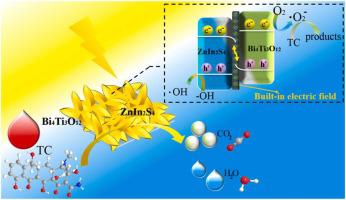Journal of Hazardous Materials ( IF 13.6 ) Pub Date : 2022-06-21 , DOI: 10.1016/j.jhazmat.2022.129438 Qi Zhou 1 , Luhong Zhang 1 , Longfei Zhang 1 , Bin Jiang 1 , Yongli Sun 1

|
Semiconductor materials dominated photocatalytic technology is one of the most efficient approaches to degrade organic pollutants. However, the limited light absorption range and rapid recombination of photogenerated carriers greatly restrict the application of photocatalysts. Rational design of photocatalysts to achieve high catalytic activity and stability is of great importance. Herein, ZnIn2S4/Bi4Ti3O12 S-scheme heterojunction is synthesized by growing the ZnIn2S4 nanosheets on the sheet-like Bi4Ti3O12 surface via a low-temperature solvothermal method. The TC removal efficiency of optimized heterojunction reaches 82.1% within 60 min under visible light, and the rate constant is nearly 6.8 times than that of pristine ZnIn2S4. The favorable photocatalytic performance of heterojunction is attributed to the tight contact interface and efficient separation of photogenerated carriers. Besides, the difference in work function between ZnIn2S4 and Bi4Ti3O12 leads to band bending and the establishment of built-in electric field on the contact interface of heterojunction, which facilitates the migration and separation of photogenerated carriers. Furthermore, the cycling test demonstrates the attractive stability of heterojunction. The possible TC photodegradation pathways and toxicity assessment of the intermediates are also analyzed. In conclusion, this work provides an effective strategy to prepare S-scheme heterojunction photocatalysts with favorable photocatalytic activity, which can enhance wastewater purification efficiency.
中文翻译:

原位构建的 2D/2D ZnIn2S4/Bi4Ti3O12 S 型异质结降解四环素:性能和机理见解
半导体材料主导的光催化技术是降解有机污染物最有效的方法之一。然而,有限的光吸收范围和光生载流子的快速复合极大地限制了光催化剂的应用。合理设计光催化剂以实现高催化活性和稳定性非常重要。本文通过在片状Bi 4 Ti 3 O 12上生长ZnIn 2 S 4纳米片合成ZnIn 2 S 4 /Bi 4 Ti 3 O 12 S型异质结。表面采用低温溶剂热法。优化后的异质结在可见光下60 min内TC去除率达到82.1%,速率常数是原始ZnIn 2 S 4的近6.8倍。异质结良好的光催化性能归因于紧密的接触界面和光生载流子的有效分离。此外,ZnIn 2 S 4和Bi 4 Ti 3 O 12的功函数差异导致能带弯曲和在异质结接触界面上建立内建电场,有利于光生载流子的迁移和分离。此外,循环测试证明了异质结具有吸引力的稳定性。还分析了可能的TC光降解途径和中间体的毒性评估。总之,这项工作为制备具有良好光催化活性的S型异质结光催化剂提供了一种有效的策略,可以提高废水净化效率。



























 京公网安备 11010802027423号
京公网安备 11010802027423号